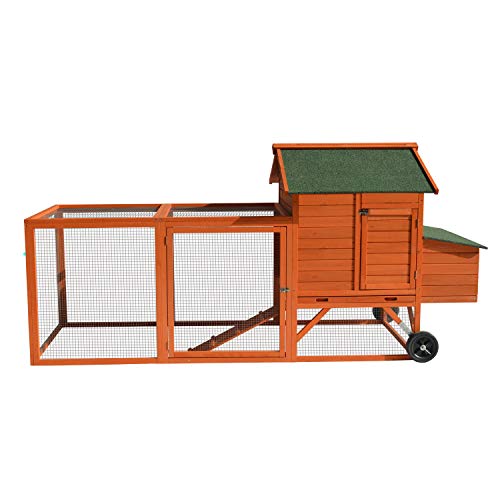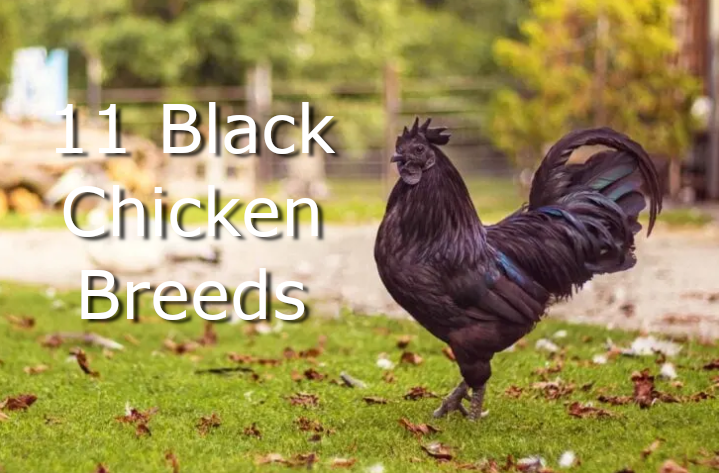
Why Raise Black Chicken Breeds
The primary reason to raise black chicken breeds is how strikingly beautiful they are. Take the Ayam Cemani, for example (number 11 on the list). If the color black was a chicken, it would be the Ayam Cemani. The chicken is black inside and out and it’s absolutely stunning.
Health benefits are another reason to raise black chicken breeds. Some of the breeds on the list don’t just have black plumage, they also have black meat. The Kadaknath is an example of a chicken with black meat (number 10). Of course, the Ayam Cemani has black meat too, but eating them will be the last thing on your mind when you see their price!
Why is black chicken meat better for you? Black chicken meat is rich in the antioxidant carnosine which, some believe, boosts the immune system.
There could also be some benefit for your birds in colder climates. Black chicken plumage absorbs more heat and can keep your chickens warmer if you live in a colder climate.
Whatever your reason for raising black chicken breeds, here’s the Backyard Chicken Tractor blog team’s list of the top 11 black chicken breeds for your backyard flock.
Black Orpington
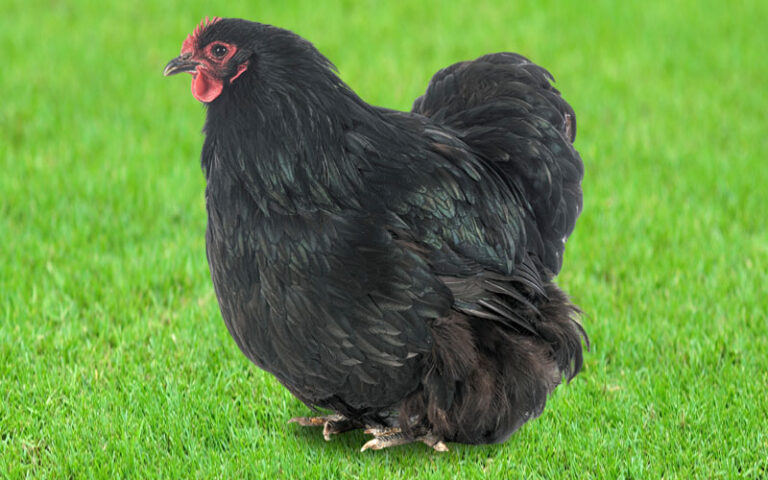
Purpose: Dual Purpose
Weight:8 – 10 lbs
Egg Production: 200 – 280 eggs a year
Black Orpingtons were first bred in 1886 by crossing Minorcas, Langshams, and Plymouth Rock chickens. This black chicken breed has had amazing success in the backyard chicken niche due to their calm temperament and their high egg production. In addition to laying over 200 large brown eggs a year, these large birds barely ever fly which makes them easy to maintain in a backyard.
Black Orpintons do well in colder climates, but can struggle in heat and humidity. If you live in hotter climates, make sure your flock has access to shade and their coop is well ventilated. They’re large birds that need at least 5 square feet in a coop and 20 square feet in a run.
Like all large breeds, the Black Orpington can pack in the feed. Full-grown chickens will eat around 5 ounces of feed every day.
Minorca
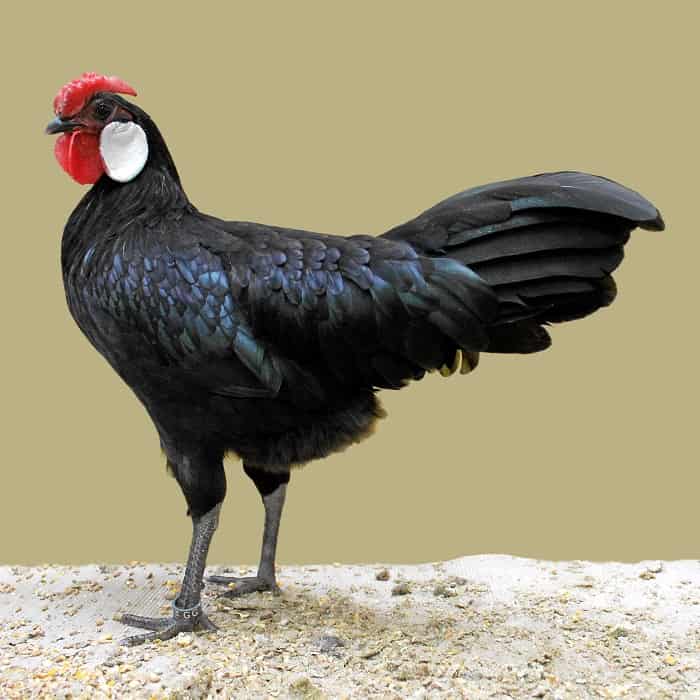
Purpose: Ornamental/Egg Layer
Weight: 8 lbs
Egg Production: 120 – 200 eggs a year
It’s hard to get much more ‘heritage’ than the Mincora. Some sources date this breed back to the Roman Empire. It first came to the United States in 1884 and was included in the American Poultry Association’s Standard Guide in 1888. Beyond that, the Minorca is known for two things – Laying amazingly large white eggs and the birds look kind of weird.
Their weird look wasn’t strange enough to land it on our list of weirdest chickens but the large white earlobes are definitely a conversation starter. Those same lobes are one of the features of the Minorca that make it less tolerant of cold weather, but they’re well-adapted to warmer climates.
The Minorca is calm and friendly, though they’re also curious and love space to run around. They’re also more flighty than the Black Orpington or Australorps which makes them a better choice if you have a lot of predators in your area. They’re also excellent foragers and will forage for most of their food if given the opportunity.
This large chicken needs at least 5 square feet in the coop and 20 square feet in a chicken run but will be happy with more. Minorcas also eat between 5 and 6 ounces of feed per day, but will get a lot of that from foraging if you let them.
Black Australops

Purpose: Dual Purpose
Weight: 6 – 8 lbs
Egg Production: 250 – 300 eggs a year
Black Orpingtons and Australorps are related. In the 1900s, some black Orpingtons we brought to Australia where the local chicken farmers crossed them with Rhode Island Reds to increase their egg production and heat tolerance
Like the Orpingtons, black Australorps are gentle giants. These large birds have a sweet temperament that makes them perfect for backyard chicken flocks. These fatties also have a hard time flying so they tend to stay on the ground which makes it easy to let them roam the yard without fear they’ll bother the neighbors.
Black Australops are slightly more feed efficient than the Orpingtons and consume between 4 and 5 ounces of food a day. Like all large birds, Black Australops need at least 5 square feet in the coop and 20 square feet in a chicken run.
Black Silkies
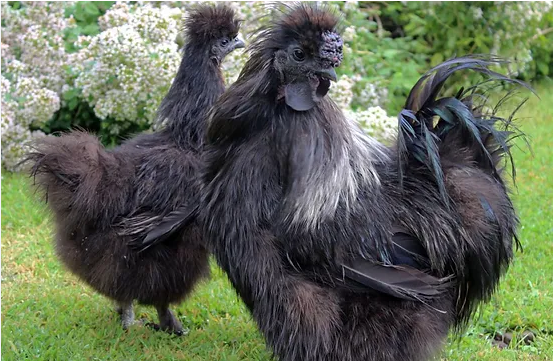
Purpose: Ornamental
Weight: 4 lbs
Egg Production: 100 eggs a year
Black Silkies are the first purely ornamental chicken on our list of the best black chicken breeds to raise. They don’t have much meat and they don’t produce a lot of eggs, but they are drop-dead gorgeous!
Black Silkies date back to the 1200s in China back when the Song Dynasty and the Mongols were fighting for power. Their name comes from their soft feathers that look more like fur. This is another black chicken breed that has black meat – though there’s not enough of it to consider actually eating them.
Silkies are sweet, friendly chickens making them great pets. They’re also unassuming and quiet – all great qualities to have for an ornamental chicken. The breed does well in both warm and cold climates, though they need ready access to shelter as their fur-like feathers are easily soaked.
Black Silkies are small birds and don’t need a lot of space. You can get by with 2 square feet in the coop and 10 square feet in the chicken run. They also don’t eat much and consume between 2.25 and 3.5 ounces of feed per day. Just make sure that both are well-protected from predators because Silkies are a small breed that can’t fly.
Sumatra
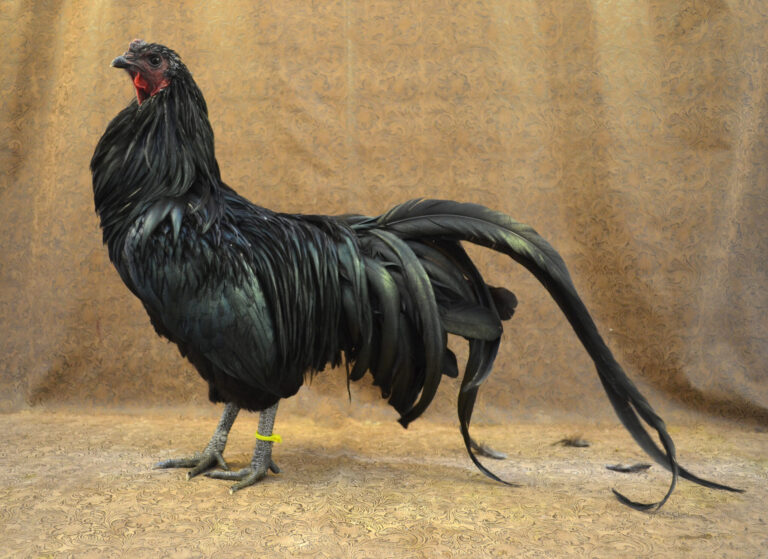
Purpose: Ornamental
Weight: 4 lbs
Egg Production: 100 eggs a year
The Sumatra came from the island of the same name in Indonesia. It’s a wild chicken that’s become pretty rare today. These chickens we originally bred for cock fighting and can be temperamental. Their wild nature also doesn’t make them well-suited to confinement and they can be flighty. All of these qualities make them rather difficult chickens to keep in a backyard flock.
Sumatra chickens do well in all climate types and don’t eat a lot of feed. In fact, they would be content to forage on their own.
It’s a good thing they’re beautiful because they sure aren’t good for much else. Breeders who keep Sumatra chickens are in love with their dark, long plumage or are dedicated to conserving endangered breeds.
-
Chic Buffet Poultry Feeder – Chicken Feeder-Food-Waterer-Baby Chicks-Ducks-Wild Birds-Bird Seed-Food-Hamster-Parakeet…
Chicken Feeders $22.50Rated 0 out of 5 -
Chick Feeder and Waterer Kit, Durable Plastic Fount for Up to 12 Chicks,Broilers Easy to Clean,Highly Practical for Coop…
Chicken Feeders $11.04Rated 0 out of 5 -
Chicken Feeder-Holds 20 Pounds-Pellets-Crumbles-Grain in Bucket – for 21st Century Chicken Owners – Inside or Outside of…
Chicken Feeders $69.95Rated 0 out of 5 -
Chicken Vegetable Hanging Feeder Toy for Hens Pet Chicken Veggies Skewer Fruit Holder for Hens Large Bird
Chicken Feeders $8.99Rated 0 out of 5
Langshan
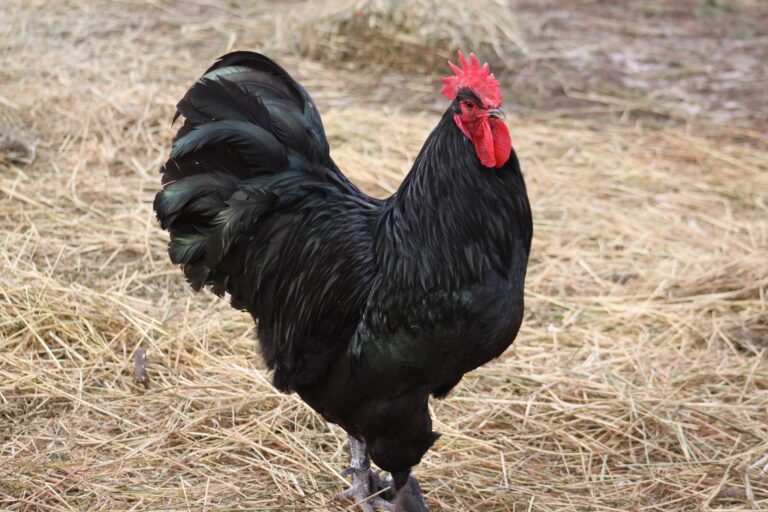
Purpose: Dual Purpose
Weight: 7 – 8 lbs
Egg Production: 150 – 200 eggs a year
The Langshan is another threatened breed. These chickens come from the Langshan district of China and first came to the United States in 1876. There are four different types of Langshan today, but the original type was the Croad Langshan.
The Langshan does well in cold climates but doesn’t do well in the heat. You can still keep them in moderately warm climates as long as the chickens have plenty of shade.
These chickens are docile and have an excellent temperament. They do well when confined to a coop with a chicken run. Just take care when letting them range free (which they love) as they’re known to fly.
This large breed needs about 5 square feet of coop space and 20 square feet of space in the chicken run. Langshan chickens will eat around 6 ounces of feed per day, though they’re excellent foragers which helps offset the cost.
Jersey Giant
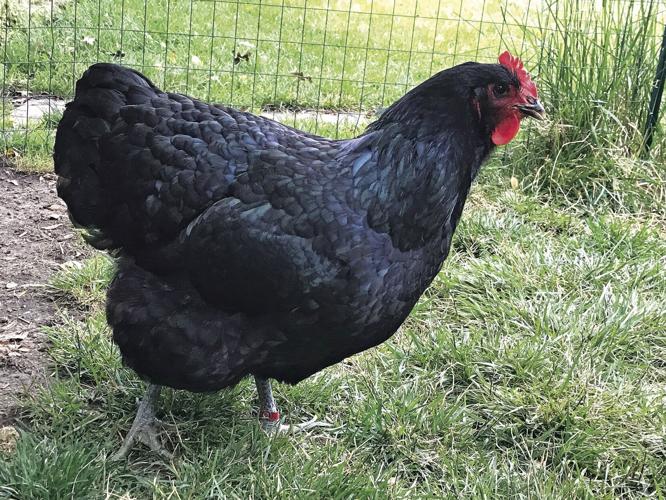
Purpose: Meat
Weight: 11 – 15 lbs
Egg Production: 150 – 200 eggs a year
No surprise that this black chicken breed was made for meat. The Jersey Giant was bred in New Jersey in the 1880s to satisfy New York’s desire for chicken meat. The fact that they’re a decent egg layer is a bonus. This chicken breed was a cross between the Black Langshan, the Black Java, and the Dark Brahma. Some sources suggest that an Orpington might also be in the mix.
Despite their large size, Jersey Giants have an amazing temperament and make excellent chickens for a backyard flock. They also tend to stay grounded so you can let them out of their run to roam your yard. These chickens are great to have in cold climates as their large size seems to make them tolerant of low temperatures.
You would think that these giants would be safe from predators, but the opposite is true. Their docile nature makes them easy targets so make sure your chicken coops and runs are well protected. These massive chickens need 6 to 8 square feet of space in the coop and 30 square feet in the chicken run.
Unfortunately, these black chickens have a pretty poor feed conversion ratio. Jersey Giants eat between 5.5 and 7 ounces per day and take about 6 months to get to a good harvest weight. Even so, their amazing temperament and egg-laying capabilities make them a solid choice for your backyard.
Swedish Black (Svart Hona)

Purpose: Egg Layer
Weight: 5 – 7 lbs
Egg Production: 200 eggs a year
The Swedish Black chicken is another chicken that has black skin and meat as well as feathers. Some confuse it with the Ayam Cemani because they look very similar. This chicken breed originated in Indonesia, but no sources say how long ago. The first records are of the Swedish Black coming to Sweden in the 1800s.
Swedish Black chickens are known to have sweet temperaments and are excellent foragers. They also fly fairly well so they’re not completely helpless if they encounter a predator. Despite their smaller size, the Swedish Black chicken does well in cold temperatures as well as warmer ones.
While these chickens are docile and friendly, their love of foraging means that they don’t take well to confinement so make sure you have plenty of space in a run if you plan to keep them in a backyard. If they’re not foraging for their food, expect to feed them around 5 ounces of feed per day. The Swedish Black chicken breed is very rare so expect to pay around $100 per chick if you decide to raise them.
La Fleche
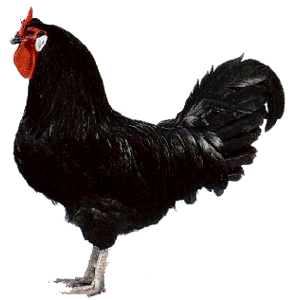
Purpose: Dual Purpose
Weight: 5 – 7 lbs
Egg Production: 150 – 200 eggs a year
The La Fleche gets its name from the horn-like comb on its head that looks like an arrow (la fleche means ‘the arrow’ in French). The breed comes from the Loire Valley of France where it dates back to the 1600s.
This black chicken breed was originally raised to be a foraging chicken – something it does exceedingly well today. The La Fleche breed will get all its food from foraging given enough room. The La Fleche can still be kept in confinement. Just be sure it has at least 6 square feet in the coop and 30 square feet in a chicken run. The more space, the better. They’re very active and decent flyers.
The La Fleche has a wild temperament. That combined with its love of foraging should put it lower on your list of backyard chicken breeds and if you lived in cold climates, it should take it off completely. The La Fleche doesn’t do well in cold weather. It is, however, very heat-tolerant.
If they’re not free foraging, La Fleche chickens will eat between 4 and 6 ounces of feed per day.
Kadaknath

Purpose: Meat
Weight: 4 – 5 lbs
Egg Production: 80 – 120 eggs a year
The Kadaknath is another black chicken breed that has black skin and meat. This chicken is by far the most budget-friendly of the black chicken breeds on this list. While still rare, they’re very reasonably priced.
While hard to find in the United States, the Kadaknath is still popular in its native India where locals believe their black flesh has a laundry list of health benefits.
We couldn’t find much about the temperament of this breed – mostly because anyone that writes about it seems more interested in eating it. It’s been bred specifically for backyard chicken raising, so it should make a good candidate to keep.
If you have any experience with these chickens, we’d love to hear about it. Drop us a line at our Contact Us page.
Ayam Cemani
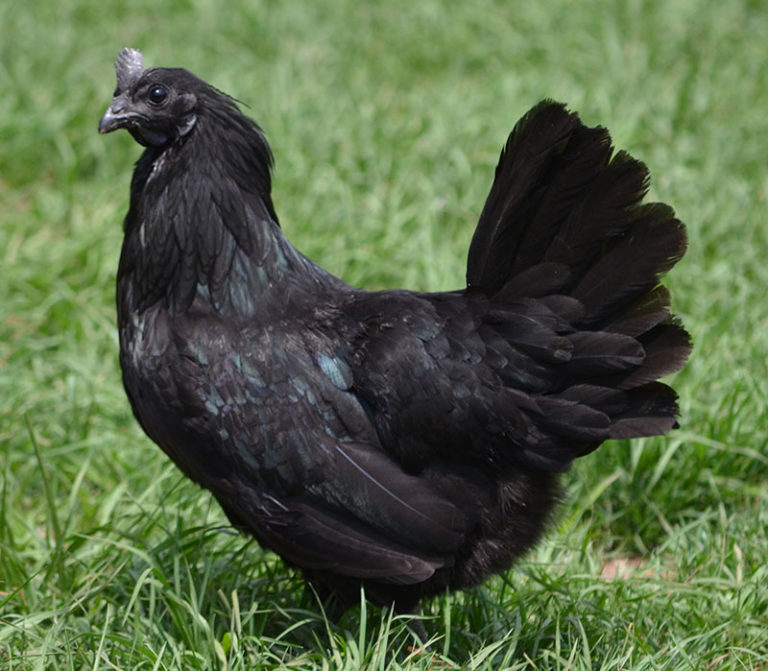
Purpose: Ornamental
Weight: 4 – 5 lbs
Egg Production: 80 eggs a year
Do you love black chickens and hate money? Then we’ve found you the perfect black chicken breed! The Ayam Cemani has black everything. Skin, meat, comb, feathers – even the inside of its mouth is black. And at up to $2500 per chicken for a breeding pair, they aren’t cheap. But they really do look amazing. Maybe even amazing enough to warrant their high price tag.
This black chicken breed comes from Indonesia where the locals revere the chicken to the point that it’s used ceremoniously as well as a status symbol for the wealthy. The Ayam Cemani is well suited to backyard chicken raising. They’re mid-sized birds and need about 5 square feet of coop space and 10 square feet of run space.
The Ayam Cemani has a sweet temperament and tolerates both hot and cold climates. It would be an amazing bird for a backyard flock if it was a decent egg layer. Unfortunately, it’s not. However, if you have a passion for raising rare chicken breeds, the price of these black chickens will certainly reward you for your efforts. Even the chicks can sell for over $100 each.
Conclusion
Black chicken breeds have a place in any backyard chicken flock. You can get great egg production from breeds like the Black Australorp, meat from the Jersey Giant, or just an amazing all-round chicken. It doesn’t matter why you keep chickens in your backyard. One of these black chicken beauties will make a great addition.
Did we forget one of your favorites? Let us know! Go to our contact page and drop us a line. We’d love to hear from you.
Need A Backyard Chicken Coop? Check These Out!
-
48”L Rabbit Hutch Indoor Outdoor Bunny Cage Rabbit Hutch Wood House Pet Cage for Small Animals (Grey/White)
Chicken Coops $159.99Rated 0 out of 5 -
96″ Deluxe Large Wooden Chicken Coop Hen House on Wheels Indoor Outdoor Rabbit Hutch Poultry Cage w/Nesting Box and Removable Tray & Ramps
Chicken Coops $269.99Rated 0 out of 5 -
Aivituvin Wooden Chicken Coop, Large Outdoor Hen House with Nest Box Poultry Cage, Rabbit Hutch – Waterproof UV Panel…
Chicken Coops $119.99Rated 0 out of 5 -
Best Choice Products 80in Outdoor Wooden Chicken Coop Multi-Level Hen House, Poultry Cage w/Ramps, Run, Nesting Box…
Chicken Coops $199.99Rated 0 out of 5












